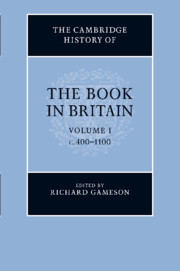Book contents
- Frontmatter
- 1 From Vindolanda to Domesday: the book in Britain from the Romans to the Normans
- PART I THE MAKING OF BOOKS
- PART II THE CIRCULATION OF BOOKS
- PART III TYPES OF BOOKS AND THEIR USES
- PART IV COLLECTIONS OF BOOKS
- 27 Patrick, apostle of the Irish
- 28 The library of Iona at the time of Adomnán
- 29 Literacy in Anglo-Saxon England
- 30 Aldhelm’s library
- 31 The library of the Venerable Bede
- 32 The library of Alcuin’s York
- 33 The library of Cynewulf
- 34 King Alfred and his circle
- 35 Ælfric’s library
- 36 The library of Byrhtferth
- 37 The library of Wulfstan of York
- 38 Rhygyfarch ap Sulien and Ieuan ap Sulien
- PART V CODA
- Bibliography
- Concordance of named manuscripts
- Index of manuscripts
- General Index
- Plate 4.1: The Lindisfarne Gospels"
- Plate 5.1: The Lichfield/St Chad Gospels"
32 - The library of Alcuin’s York
from PART IV - COLLECTIONS OF BOOKS
Published online by Cambridge University Press: 28 March 2012
- Frontmatter
- 1 From Vindolanda to Domesday: the book in Britain from the Romans to the Normans
- PART I THE MAKING OF BOOKS
- PART II THE CIRCULATION OF BOOKS
- PART III TYPES OF BOOKS AND THEIR USES
- PART IV COLLECTIONS OF BOOKS
- 27 Patrick, apostle of the Irish
- 28 The library of Iona at the time of Adomnán
- 29 Literacy in Anglo-Saxon England
- 30 Aldhelm’s library
- 31 The library of the Venerable Bede
- 32 The library of Alcuin’s York
- 33 The library of Cynewulf
- 34 King Alfred and his circle
- 35 Ælfric’s library
- 36 The library of Byrhtferth
- 37 The library of Wulfstan of York
- 38 Rhygyfarch ap Sulien and Ieuan ap Sulien
- PART V CODA
- Bibliography
- Concordance of named manuscripts
- Index of manuscripts
- General Index
- Plate 4.1: The Lindisfarne Gospels"
- Plate 5.1: The Lichfield/St Chad Gospels"
Summary
Where books are kept
Small roofs hold the gifts of heavenly wisdom;
Reader, learn them, rejoicing with a devout heart.
The Wisdom of the Lord is better than any treasures
For the one who pursues it now will have the pathway of light.
York’s remarkable eighth-century library supported a school of European renown. By the third quarter of the ninth century, the school had long since faded from prominence, and the books that had not been dispersed were probably destroyed during struggles with Danish invaders. The library’s floruit had spanned a mere few decades – the careers of two teachers. The evidence for the accumulation, contents and character of the books collected at York differs significantly from the evidence available for the libraries of Canterbury and Wearmouth-Jarrow: vivid obiter dicta from letters and a handful of poems that lend themselves more easily to sketching a portrait in a landscape – albeit one in chiaroscuro – than to reconstructing a precise catalogue. Yet the evidence for York Minster’s library might just as aptly be compared to a long beam of light as to materials for a portrait, for it illuminates not just library history, but early medieval intellectual history and the social world of a unique book collection and of learning more generally – and this, almost entirely from the distinctive perspective of a single individual, Alcuin of York (d. 804).
Alcuin would be remembered as ‘the most learned man anywhere to be found’ or as ‘a man most learned in every field’. His learning drew students to the school of York from Ireland, and even from the Continent. It also led the great Frankish ruler Charlemagne to enlist him as an advisor. And so Alcuin spent the second half of his life in Francia, first at Charlemagne’s court and later at Tours, where from 796 he served as abbot and continued to teach.
- Type
- Chapter
- Information
- The Cambridge History of the Book in Britain , pp. 633 - 664Publisher: Cambridge University PressPrint publication year: 2011
- 6
- Cited by

